Revised 23 April 2022
Accepted 24 October 2022
Available Online 21 November 2022
- DOI
- https://doi.org/10.55060/s.atssh.221107.032
- Keywords
- Guanyin statue
Porcelain statue
Artistic image - Abstract
Statues are an important medium for the dissemination of Buddhism. As a Buddhist deity introduced to China during the Han Dynasty, Guanyin became the goddess of the Chinese people after a process of feminization and secularization. Talented people used a variety of art forms to create one after another classic Guanyin images, and the statues of Guanyin in the Ming and Qing Dynasties were even more prominent. In the 17th century, various cultures such as Confucianism, Buddhism, Taoism and Christianity collided with each other. The statue of Guanyin showed an artistic image with unique characteristics of the times. It represented not only the inheritance of Buddhist culture, but also the epitome of the times.
- Copyright
- © 2022 The Authors. Published by Athena International Publishing B.V.
- Open Access
- This is an open access article distributed under the CC BY-NC 4.0 license (https://creativecommons.org/licenses/by-nc/4.0/).
1. INTRODUCTION
Guanyin was a Mahayana Buddhist bodhisattva who was introduced to China along the Silk Road in the Eastern Han Dynasty [1]. By the Ming and Qing Dynasties, the belief in Guanyin and the culture of Guanyin were firmly rooted in the hearts of the Chinese people [2]. And folk artists and talented people expressed their reverence for Guanyin in art forms such as stone carvings, ceramic sculptures and paintings. During the Sui and Tang Dynasties, with the development of porcelain-making crafts in northern and southern China, many kiln sites for firing Buddhist-themed ceramics were discovered in the central and southern regions. In the Ming and Qing Dynasties, the firing of statues of gods and Buddhas became more prevalent, and many high-quality porcelain sculptures appeared. The porcelain sculptures of Guanyin from the 17th century were not only characterized by traditional Chinese aesthetics, but also reflected the integration of many cultures, including Confucianism, Taoism and Christianity.
2. BASIC INFORMATION ABOUT THE PORCELAIN SCULPTURES OF GUANYIN IN THE 17TH CENTURY
Guanyin statues in the 17th century were mainly from the Dehua kilns [3]. The Dehua kilns produced a very large number of products with excellent quality, fine flesh and elegant tones. For example, the sitting statue of Guanyin, now in the Asian Art Museum in San Francisco, worn a crown of flowers, had vivid and delicate features, was adorned with a necklace on its chest, and was dressed in a long garment with wide sleeves. In addition, with the white glaze of Guanyin statue, people can see the dignity, demure and kindness. Also, Cizhou kiln, Longquan kiln and Jingdezhen kiln produced the Guanyin statue. Cizhou kiln continued to produce Guanyin in the same style as that of Yuan Dynasty, with black flowers on a white background. For example, the sitting statue of Guanyin, with a white background and black flowers, now in the San Francisco Museum of Art, was covered in white glaze, with black-colored decoration on the eyebrows, eyes, collar and pedestal. Longquan kiln also continued the artistic style of Yuan Dynasty, with the statue mostly covered in green glaze and the body exposed to the glaze. For example, the blue-glazed niche statue of Guanyin from Longquan kiln, now in the Wenzhou Museum, had a light-brown face and body, with a light-green glaze on the drapery and a transparent green glaze inside and outside the niche. At this time, although Jingdezhen kiln occupied a central position in the Chinese porcelain industry. According to the quantity and quality of ceramic statues of Guanyin from this period, Dehua kilns were slightly superior to Jingdezhen kilns. Therefore, Dehua kiln became the main kiln for the production of ceramic statues of Guanyin in the Ming and Qing Dynasties, with other kilns competing to imitate it. As a Chinese “specialty”, ceramics were sought after by many foreign aristocrats. In addition to the major museums in China and the museums where the kilns were located, museums and private in foreign countries also had collections, such as, enamel painted porcelain statues of Guanyin from the Dehua kilns during the Kangxi period in the Victoria and Albert Museum in the United Kingdom, a sitting statue of Guanyin from the Metropolitan Museum of Art in the United States, a statue of Guanyin in the 17th century from the National Art Collection in Dresden of Germany, a standing statue of Guanyin in the 17th century from the Dehua kilns in the National Gallery of Victoria in Melbourne of Australia, and a standing statue of Guanyin from the National Gallery in Amsterdam of the Netherlands.
When Guanyin statue was first introduced to China, it maintained the image of a “brave man”, with a burly body, well-developed muscles and a slight beard. In the Ming and Qing Dynasties, the statue of Guanyin had undergone the evolution process from male to female and from the sacred to the secular, and its image tended to be stable and had a profound impact on future generations [4].
3. EVOLUTION OF THE GENDER, SHAPE AND ARTISTIC STYLE OF GUANYIN
3.1. Feminization
The gender origins of Guanyin should go back as far as the Buddhist texts of the Guishuang period in ancient India. According to the corresponding Buddhist texts, the prototype of Guanyin was probably a male bodhisattva, which later evolved into the various images people know by the hands of a Buddhist. In “Saddharmapundarika Sutra · Arya Avalokiteshvara Fumon, No. 25”: “...there are infinite millions of sentient beings hearing that Guanyin was a male...” [5]. During the Han Dynasty, the belief in Guanyin was widely spread in China. After the cultural fusion of the Six Dynasties and the Sinicization of Buddhism in the Sui and Tang Dynasties, the image of Guanyin changed in terms of gender. In the Five Dynasties and Song Dynasties, the image of Guanyin was basically feminine. Among them, there were three more obvious stages.
The first stage was in the Wei, Jin, Southern and Northern Dynasties. Most of the time during this period was in war and chaos, and the people were displaced and suffering. Guanyin was popular because of its mercy and salvation, and Guanyin statues also increased with the influence of Gandhara. For example, the painted stone statue of Guanyin in the Northern Qi Dynasty in the Metropolitan Museum of Art (Fig. 1) had delicate and pretty face, slightly closed eyes, a plentiful and substantial body, a long neck and narrow shoulders, and precious stones and other decorations on the top of the head, chest and lower body, showing the holiness and tranquility. The statue clearly had the characteristics of a man.
The second stage was during the Sui and Tang Dynasties, which was politically stable, economically developed, and culturally prosperous. It could be seen from the grotto statues that although the Guanyin statues generally retained the male body, their faces tended to be female, with a female style. For example, the stone statue of Guanyin in the Cleveland Museum of Art from the Tang Dynasty (Fig. 2) was standing in an ‘S’ shape, with dignified features, bare upper body, a drape on body, a necklace, collar and bracelets. At the same time, the lower body was covered with a close-fitting underskirt, and the bare feet were standing on a lotus platform. Therefore, the beauty of the female was expressed.
The third stage was during the Five Dynasties and the Song Dynasties, when the statue of Guanyin was almost entirely female, except for the chest, which was preserved as a child's chest [6]. For example, according to the 125th niche of the Dazu stone carvings from the Northern Song Dynasty (Fig. 3), the statue of Guanyin stood slightly sideways, with a beautiful crown on its head, soft facial features and kind eyebrows. Its arms were bare, and both hands were folded naturally in front of the abdomen. The clothing was decorated with wreaths and beads, and it stood on a rosette, with tender and gentle expression. Since then, most of the statues of Guanyin appeared in the public's visions with the female appearance, and the female posture presented fully reflected the aesthetic characteristics of various dynasties.
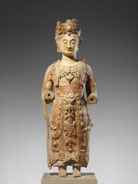
Painted stone statue of Guanyin (Northern Qi Dynasty). Source: https://www.metmuseum.org/art/collection/search/42718
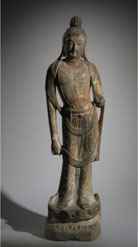
Stone statue of Guanyin (Tang Dynasty). Source: https://www.clevelandart.org/art/1966.364
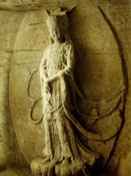
Standing statue of charming Guanyin (Northern Song Dynasty). Source: [7], p.121.
3.2. De-Buddhism
During the Wei, Jin and Northern Dynasties, since the introduction of Buddhism, monolithic Buddha statues became popular. During this period, artisans made statues of Guanyin in strict accordance with the ancient Indian rituals of statue-making, producing statues with a saintly face and a serene physique that were clearly reminiscent of the statues of Guanyin in Gandhara period of ancient India, fully demonstrating the compassionate spirit and transcendent mood of Guanyin. At the same time, influenced by the aesthetic style of the Wei and Jin Dynasties, the statue of Guanyin showed the beauty of “beautiful bones and clear features”, with the noble and elegant, airy, relaxed, serene and wise temperament. For example, the statue of cross-legged Guanyin from the Yungang Grottoes in the Northern Wei Dynasty in the Metropolitan Museum of Art (Fig. 4) had a crown with a small Buddha in it. With a smile on face, curved eyebrows and fine eyes, straight nose and small mouth, she looked down at all living beings, and worn silk on her shoulders and a full-length skirt, being elegant and dignified and carefree. The belief in Guanyin retained both the legacy of ancient India and the local aesthetic styles.
By the Tang Dynasty, in order to better popularize the belief in Guanyin, some monks transformed the image of Guanyin to make it more approachable to the people. The statue of Guanyin gradually departed from the delicate and pretty image and took on a graceful and elegant female appearance. For example, the stone carving of eleven-face Guanyin statue in the Early Tang Dynasty in the Boston Museum of Art (Fig. 5) was dignified in facial features, with willow in the left hand and jade bottle in the right hand, gem and jewellery on the whole body. Guanyin statues went further to the world.
The complete localization of Buddhism in the Song Dynasty further diluted the sacredness of Guanyin. The statue of Guanyin had a more gentle and elegant look of a woman in Song Dynasty. For example, the sitting statue of Zizhu Guanyin in the Anyue Grottoes in Sichuan (Fig. 6) worn a crown, had soft facial features and benign face. Guanyin touched Padmasana with her left hand, put right hand on the bent knee, and stood on the louts with her left foot naturally, showing a sense of ease and pure beauty. Through the evolution in Tang and Song Dynasties, Guanyin statue basically broke away from the influence of Gandhara style in ancient India and became an artistic style in line with the aesthetic taste of Chinese people [8].
During the Liao, Jin and Yuan Dynasties, there were frequent wars, military conflicts, social unrest, displacement of people and obvious conflicts between ethnic groups and close exchanges, and the development of Buddhism was affected. At this time, the statue of Guanyin retained the statue style of the Tang and Song Dynasties, while the characteristics of the northern people were enhanced in terms of face and body, with a more realistic character. The statues of Guanyin from the Yuan Dynasty were heavily influenced by the folk art of Yuanqu, further catering to the aesthetic needs of the people and pursuing dramatic effects. During the Ming and Qing Dynasties, the statues of Guanyin were mostly on middle-aged women with simple clothes and more diversified in theme selection and style expression. During this period, the statue style of Guanyin was quiet, serene and elegant. The sense of majesty and sacredness of religion had been very weak, and the aesthetic taste of the people was enhanced.
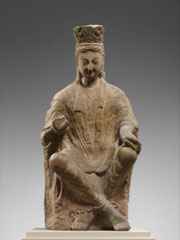
Cross-legged Guanyin of Yungang Grottoes (Northern Wei Dynasty). Source: https://www.metmuseum.org/art/collection/search/42711?ft=guanyin&offset=0&rpp=40&pos=4

Stone carving of Early Tang Dynasty in Chang'an: the eleven-faced statue of Guanyin. Source: https://collections.mfa.org/objects/24276/elevenheaded-guanyin-bodhisattva-of-compassion?ctx=95093cb1-1158-4491-9573-19e760466ada&idx=0
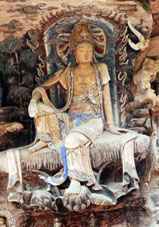
Sitting statue of Zizhu Guanyin in Anyue Grottoes of Song Dynasty. Source: https://baijiahao.baidu.com/s?id=1647448223934226212&wfr=spider&for=pc
3.3. Miniaturization
During the Wei, Jin and Northern Dynasties, opening of caves and building of monasteries was prevalent in northern China, and large numbers of monolithic Buddha statues were made. Guanyin statues were also found in these caves, such as the Yungang Grottoes, the Maizishan Grottoes and the Mogao Caves. In addition to the stone statues, there were many gold and bronze Buddha statues left from the Wei and Jin Dynasties, and most of them were bronze Buddha statues. Because of the need for pilgrimage and the specificity of the material, these Buddha statues were larger in size. The reason was that large statues could better express the devotion of the followers to Buddhism and satisfy the worship of the faithful.
After the Tang Dynasty, large-scale cave-making activities declined sharply. Since the Five Dynasties, the wars between Song Dynasty and Liao Dynasty were fought in successive years, resulting in a massive shortage of copper resources for smelting weapons and limiting the casting of traditional gold and bronze Buddha statues. The demand for small Buddha statues in family Buddhist halls and monasteries increased, however, ceramic statues and wood carvings took off. The production of porcelain statues of Guanyin began in the Tang Dynasty. By the Song and Yuan Dynasties, famous kilns such as Jingdezhen kiln in Jiangxi, Longquan kiln in Zhejiang, and Dehua kiln in Fujian had reached a very high level in the production of porcelain statues of Guanyin. Due to the particularity of the ceramic material, the fired Guanyin figurines were small in size. Because of the decline of the caves, stone carving declined. With the rise of wooden temples, the art of wood carving was popular. Due to the convenience of wood carving, the lightness of the material used and the plasticity of the form, as well as the need for a variety of styles, wood carving was prevalent. Particularly, in the Liao and Jin Dynasties, wooden carvings of Guanyin were most prominent. During the Ming and Qing Dynasties, Guanyin statues were rarely found in large cave sculptures and murals, but instead a large number of more marketable paper cuttings, porcelain sculptures, jade sculptures and small stone carvings emerged. As beliefs in de-Buddhist of Guanyin was deepened, the materials and forms of Guanyin statues changed from the single to the diversified, and the forms evolved from large temple statues to small decorative statues met the daily needs of people.
4. PORCELAIN STATUE OF GUANYIN IN THE 17TH CENTURY
From the above analysis, the Guanyin statue has undergone a process from the male Guanyin of ancient India to the female Guanyin of the Five Dynasties and Song Dynasties, from the sacred to the secular, and from large cave statues to small statues in a variety of materials. Among the many porcelain statues of Guanyin in the 17th century, porcelain statues were well known. What was the specific porcelain statue of Guanyin in this period?
4.1. Hair Style and Ornaments
The main styles of hairstyles for porcelain statues of Guanyin from the 17th century included three elements: a cowl-like hat, an eight-shaped bun, and a twist-shaped hair ring. In addition to the hairstyles containing these three elements, curly hair with Western characteristics appeared on the statues because of Christian activity.
The hair ornaments in this period were mainly divided into two categories: the ornaments with obvious Buddhist meaning, such as Nirmana-Buddha and ornaments with stronger decorative functions. However, due to the deepening of de-Buddhism in belief, Nirmana-Buddha appeared less, and there were only about ten statues. Besides, its shape was gradually simplified, which did not fully meet the standard shape of traditional Buddha. As for ornaments with stronger decorative functions, there were hairpins, rooftop crowns and garlands. Hairpins were commonly used by women in the 17th century to fix hair bun, which often appeared together with Panhuan bun in Guanyin statues. In addition, the shape of the Tiantai crown was relatively uniform, which was decorated with vines and pearls. Huaman was mainly composed of patterns, mostly in the form of hair combs. This type of ornament appeared more frequently for its distinctive decorative aesthetic.
4.2. Faces
Facially, unlike the more contoured and three-dimensional figures of the Tang Dynasty, the figures in 17th century were less linear and tended to be flatter and more amiable. The faces of Guanyin in this period were largely similar, and could even be described as one-sided. However, with the influence of foreign and secular culture, Guanyin statues showed a distinctly Western style in the late Ming and early Qing Dynasties, with a squared-off face and clear contour lines, which differed considerably from the face of the traditional Guanyin.
4.3. Costume
In general, the costume of the Guanyin statue can be divided into two forms: the celestial garment and the Chinese costume [9]. Celestial clothing was the traditional Buddhist costume, which was used by a few statues of Guanyin. The costume of Han nationality referred mainly to costumes of Ming Dynasty, such as the shawl and the cowl-like hat. These were accessories worn daily by all classes in the Ming Dynasty. It was noteworthy that most Guanyin statues were dressed in the style of cross-necked, right-overlapping garments, with wide sleeves and large cannons, or with a single skirt and garment. Most of them were worn in the style of a woman. It was noteworthy that two Guanyin statues worn exotic costumes from this period.
4.4. Accessories
The accessories of the Guanyin statue include a collar, ribbon, necklace, jade ornament, wrist bracelet and arm bracelet. Similar to the situation of hair accessories, except for the diamond-shaped pattern of jade or pearl necklace, its shape still remained the traditional standard shape, and the religious meaning of other accessories had been greatly weakened, focusing on decoration and scene creation.
The porcelain statues of Guanyin from this period were very much of their time, with a clear tendency towards secularization and a weakening of their original religious character. While inheriting traditional Buddhist beliefs, they also incorporated various cultures and the lives of Han nationality, bringing Guanyin closer to the people and fully reflecting the integration and mutual influence of many cultures.
5. FORMATION OF THE PORCELAIN STATUE OF GUANYIN IN THE 17TH CENTURY
5.1. Religious Policy
At the beginning of the Ming Dynasty, the supreme ruler dedicated himself to advocating Neo-Confucianism. The emperor Taizu of the Ming Dynasty adopted the policy of making full use of and strictly controlling Buddhism. Although the emperor Chengzu of the Ming Dynasty adopted the policy of protecting Buddhism, its basic ruling thought was still Neo-Confucianism, and excessive worship of Buddhism was not allowed [10]. Later rulers continued this policy. In the Qing Dynasty, the rulers further strengthened the autocracy of monarchy, worshipped Confucianism, and still took a strict control and utilization attitude towards Buddhism in the mainland. Therefore, the statue of Guanyin at this time was similar to that of the previous dynasty. The religious policies adopted by the rulers had a direct impact on the development of Buddhist theory in this period. At the same time, Buddhist belief also existed in the way of meeting the realistic wishes of believers. Guanyin belief continued to integrate into folklore and Confucianism and Taoism, providing a good creative environment for folk capable talents. The number of Guanyin statues increased sharply and the degree of secularization deepened in the Ming Dynasty, which was clearly reflected in its theme, hairstyle accessories, accessories and so on.
In terms of subject matter, the number of statues of Songzi Guanyin increased significantly, and Songzi Guanyin came from the folklore Songzi Niangniang. And then, there were different postures and shapes of Songzi Guanyin. It is said that the Drakan and Sudhana are attendants (Fig. 7). Usually, the Drakan holding pearls was at the lower right side of Guanyin, and the heavenly ribbon was at the lower left. Sudhana's hands were folded together. This shape was related to the folk legend of “holding pearls and seeking money”. As for accessories, the shape of parrot (Fig. 8) began to appear in the Guanyin statues in the South China Sea and the Guanyin statues sitting on the rock, and the parrot came from the folklore of “parrot flying across the South China Sea”. According to the emergence of Songzi Niangniang, Drakan and Sudhana and parrot, Guanyin belief was directly affected by secular culture and was more closely related to the secular wishes of believers. In terms of hairstyle accessories, there were many traditional costume elements of Han nationality in Guanyin's costumes, and the main styles of clothes were the styles of women in this period. In addition, the cloak in the statue was also the main accessories of women of Han nationality in the 17th century. Huaman and Tiantai crown appeared frequently in the accessories of Guanyin statue, while Nirmana-Buddha Crown with obvious Buddhist significance rarely appeared. This proved the deepening of the de-Buddhist of Guanyin.
During the Wei, Jin, Southern and Northern Dynasties, a tripartite confrontation was formed among Buddhism, Confucianism and Taoism, and the concept of three religions began to appear and be widely accepted. After the lectures and integration of the three religions in the Sui and Tang Dynasties, the confluence of the three religions roughly took shape in the Northern Song Dynasty, and became the mainstream thought of society since the Ming Dynasty [11]. As one of the most prominent gods of Buddhism, Guanyin statues fully reflected the unity of the three religions in the 17th century. Besides, it was especially reflected in accessories. For example, Qingniu (Fig. 9) appeared in the two standing statues of Guanyin in this period, and Laozi, the founder of Taoism, rode Qingniu. Carp (Fig. 10) was called Chihuigong in Taoism, which occupied a very sacred status. Usually, it appeared in the fisher girl Guanyin together with the shape of creel. As one of the most popular instruments of the Taoist school, the gourd-shaped “jade bottle” is one of the accessories of Guanyin (Fig. 11). In the Guanyin statue, the boy on the right side wore a robe, held the Sutra, and asked Guanyin for advice, reflecting the influence of Confucian culture (Fig. 12). During this period, the objects held by Guanyin mainly included Ruyi, Sutra, beads, plum vase, small table, etc. These accessories were not only full of the life interests of scholars, but also fully showed the integration of Confucianism, Buddhism and Taoism.
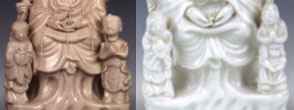
Drakan and Sudhana. Source: [12], p.28 (left) and p.18 (right).
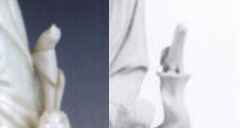
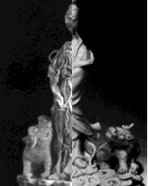
Qingniu. Source: [5], p.79 (left) and p.77 (right).
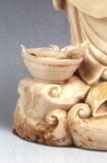
Carp, creel. Source: [12], p.32.
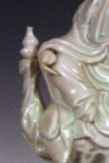
Gourd-shaped jade bottle. Source: [12], p.9.

Robe. Source: [5], p.58.
5.2. Popularity of Belief in Guanyin at All Levels
During the Ming and Qing Dynasties, various legends and allusions related to Guanyin continued to improve and spread widely at all levels. Guanyin belief had been further popularized. Its followers ranged from emperors, generals, dignitaries, wealthy businessmen, ordinary people, and even people of three religions and nine schools of thought [9]. At the same time, the Pure-land School was also popular among the people, and many folk religious organizations derived from it had further promoted the popularization of Guanyin belief. For example, Luo School, which rose in the Ming Dynasty, worshipped Guanyin, read the “Guanyin Sutra”, and built Guanyin Zhaitang [14]. People's belief in these religious groups made Guanyin belief more and more popular among the people, and also made more civilians place their secular wishes on it. For example, the increase in the number of Songzi Guanyin fully reflected people's desire for children; Malangfu Guanyin was respected by the believers because of its legend and the unique charm of kindness and beauty, which reflected the secular desire of the believers for a happy marriage.
The literati in the Ming Dynasty were knowledgeable, with high cultural literacy and certain attainments in Buddhist theory. When promoting popularization of Buddhist culture, they also promoted the integration of the three cultures. Mutual influence and promotion of development accelerated popularization of Guanyin belief, and Guanyin statues presented also increased the interest of scholars, which were reflected in the clothing and accessories in the statues. For example, as the main accessory of Guanyin, the plum vase shape was full of humanistic interest (Fig. 13). In addition to the plum vase, Sutra (Fig. 14), phylactery (Fig. 15) and beads (Fig. 16) reflecting the life interest of literati also often appeared in Guanyin statues. Guanyin statues in this period mainly had two types of cowl-like hats. One was like a kerchief (Fig. 17), which was decorated on the top of the head and naturally hung down to the shoulders, and the other was like a surcoat (Fig. 18), which was directly connected with the clothes. Both kinds of cowl-like hats were typical costumes of the literati and common people.

Plum bottle. Source: [12], p.19.

Sutra. Source: [12], p.32.

Phylactery. Source: [12], p.17.

Beads. Source: [15], p.48.

Kerchief. Source: [15], p.11.
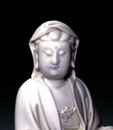
Surcoat. Source: [13], p.35.
5.3. Influence of Foreign Culture
From the 15th-18th century, Europeans carried out global maritime expansion activities, opening the age of great navigation [16]. In China, during the Han Dynasty, since Emperor Wu of the Han Dynasty, the maritime silk road was opened up. After development of the Wei and Jin Dynasties, with the prosperity of the Sui and Tang Dynasties and the prosperity of the Song and Yuan Dynasties, the route of the maritime silk had been extended to the world by the 17th century. Against the background of the “Maritime Silk Road” and “Great Navigation”, large ports in China's coastal areas, such as Quanzhou port, were inhabited by tens of thousands of foreign people from all walks of life and occupations. These people could not only do business freely, but also believe in religion freely. Therefore, various religions, including Islam, Christianity and Catholicism, took root in the area.
In the era of great navigation, there were close exchanges between various places, and the precious porcelain from China was loved by European princes, nobles and upper-class society due to its uniqueness and artistry. Porcelain was not only a work of art, but also a wealth and status symbol. Therefore, European countries set off a “ceramic fever”. Because of the need for ceramic products in the foreign market, Dehua kiln and other kilns were adjacent to the port, with low cost and high quality, which attracted the favor of countless foreign traders. At the beginning, they directly purchased in bulk. In order to better sell, customized products began to appear later, such as, the statue of Adam and Eve, the statue of St. Anthony in Padua, the statue of the Virgin Mary holding the body of Christ, the statue of the sacred heart of Christ, etc. The customized products were often related to foreign culture, and the kilns also integrated them into the production of other products. One of the most typical was Christian culture. At the end of the 16th century, Christianity began to preach in China.
To better preach and sell porcelain, as well as the similar core of Songzi Guanyin and the Virgin and the son of God, the two were integrated in the statue (Fig. 19). Among them, Songzi Guanyin also had obvious exotic style. For example, the facial depiction, high nose, deep eyes and round head all showed characteristics of Westerners, which fully proved the influence of foreign culture. In addition to its influence on the theme, foreign culture was also reflected in accessories, clothing patterns, jewelry and carving lines. For example, in this statue of Songzi Guanyin in the late Ming Dynasty (Fig. 20), the boy held Buddhist sutras, and the robe was similar to the robe of Christian missionaries. Buddhist sutras were square rather than the common thin cylindrical shape (the Buddhist sutras in this period mostly appeared in the form of volumes as accessories, and the shape was a slightly concave cylindrical shape), which was quite similar to the shape of the Bible. At the same time, the look of the child seemed to be communicating with Guanyin instead of asking for advice, with certain missionary meaning. In another sitting statue of Guanyin, a T-shaped (cross-shaped) pattern of jade or pearl necklace appeared (Fig. 21). This kind of jade or pearl necklace was composed of successive beads. The common shape was a successive bead chain with a tassel. The shape of Yingluo pattern was quite similar to that of Christian Cross statues.
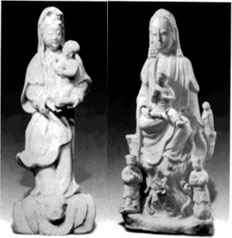
Songzi Guanyin. Source: [5], p.324.
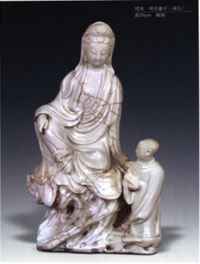
Guanyin Tongzi. Source: [12], p.19.
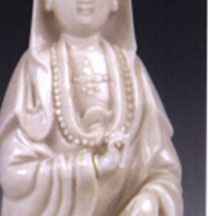
T-shaped pattern of jade or pearl necklace. Source: [12], p.33.
6. CONCLUSION
The Guanyin statues in the 17th century contain not only the localization of foreign culture, but also the integration of multiple cultures. Ceramic Guanyin statues have also deviated from the strictly prescribed style of Buddhist rituals and become beautiful scenery in the history of Chinese ceramic statues. This not only reflects the inclusiveness of the Chinese culture, but also shows the spirit of innovation and breakthrough of ancient craftsmen in China.
REFERENCES
Cite This Article

TY - CONF AU - Min Li AU - Chunji Xie PY - 2022 DA - 2022/11/21 TI - The Artistic Image of Guanyin Porcelain Statue in the 17th Century BT - Proceedings of the 8th International Conference on Arts, Design and Contemporary Education (ICADCE 2022) PB - Athena Publishing SP - 199 EP - 208 SN - 2949-8937 UR - https://doi.org/10.55060/s.atssh.221107.032 DO - https://doi.org/10.55060/s.atssh.221107.032 ID - Li2022 ER -









